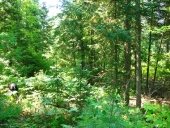Hello Jim,
After reading about your issue and plan, it appeared to me that perhaps there is another alternative that you had not yet considered.
Do you have a
compost pile yet?
If not why not start one and add these tips into your compost pile, then once your compost is ready you can apply that to your garden ultimately achieving your end goal of re utilizing the plants your cutting down.
Best of luck saving those trees!
Cheers
Takaya Chi






